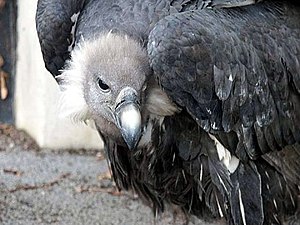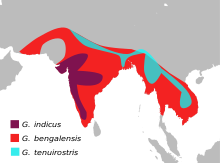Bengal vulture
| Bengal vulture | ||||||||||||
|---|---|---|---|---|---|---|---|---|---|---|---|---|

A Bengal Vulture ( Gyps bengalensis ) |
||||||||||||
| Systematics | ||||||||||||
|
||||||||||||
| Scientific name | ||||||||||||
| Gyps bengalensis | ||||||||||||
| ( JF Gmelin , 1788) |
The Bengal Vulture ( Gyps bengalensis ), often also Pseudogyps bengalensis , is a bird of prey from the subfamily of the Old World Vultures (Aegypiinae).
The Bengal vulture is an example of a species that was originally common, whose population suddenly collapses without warning and is thus on the verge of extinction. The Bengal vulture was still common on the Indian subcontinent and from Nepal to Pakistan towards the end of the 1980s. Within 15 years, however, there was a decline of 99.9 percent.
features
The Bengal Vulture is similar to the Griffon Vulture ( Gyps fulvus ), but is slightly smaller. The bare head and neck are gray-blue to dark blue in color, the back of the head and the back of the neck are rather darker than the front. The belly is lighter and has occasional white feathers. The ruff is snow white to light gray. The length of a Bengal vulture can be up to 95 cm, while the weight is between 3.5 and 5.5 kg. Its wingspan is around 210 cm to 280 cm.
Food and hunting
The Bengal vulture is a pure scavenger . Large groups of more than 50 vultures often gather around animal carcasses to eat. They devour everything, even bones. But sometimes the birds overeat and can hardly or not at all take off from the ground.
Reproduction
The breeding season lasts from October to February. The vultures breed in colonies of 20 to 40 pairs on tall trees. The number of whitish-green eggs is one to two. The incubation process, in which both parents participate, can take 40 to 55 days. The nestling period of the young birds is another 80 to 90 days.
Spread & threat
Bengal vultures live in Myanmar , Indonesia , India , Southeast Asia , Afghanistan, and Southwest China . They prefer open tree landscapes and form different groups with other vulture species. Their life expectancy is 20 to 25 years; the species is endangered according to the status of IUCN . The stock has plummeted by 99.9 percent since 1993. The first signs of a noticeable decline came from the Keoladeo National Park in the Indian state of Rajasthan . The species was originally very common in this national park south of Delhi. In the breeding season 1987–1988 there were still 353 clumps with breeding pairs. In 1996–1997 there were suddenly only 150 eyries, from 1998–1999 only twenty and in 2003 the Bengal vulture had become extinct in this national park. Several teams from the Bombay Natural History Society began investigating the situation of vultures in other parts of India very early on and found that the decline was also occurring in other areas. Several million vultures are believed to have died by 2007; the Bengal vulture population had decreased to possibly only 2,500 individuals. Several other Asian vulture species, such as the thin-billed vulture and the narrow- billed vulture, were also affected by the population decline .
Initially, it was suspected that the vultures had died of an infectious disease. When examining tissue samples, however, the active ingredient diclofenac was discovered to be the cause of vulture death . Diclofenac is an anti-inflammatory drug that has been used to treat injured domestic cattle more often. If such a cattle died and vultures ate from the carcass, the vultures suffered fatal kidney failure. Diclofenac is used routinely across South Asia; Its use turned out to be problematic especially where it is forbidden to followers of Hinduism to eat beef. In these regions, a dead cattle is usually left at the place of death, where it is then eaten by the vultures.
Protective measures
The use of diclofenac in veterinary medicine was banned very quickly in both Nepal and India after its harmful effects on vultures were recognized. This was largely due to the fact that with the decline in the number of vultures, the rat population and the number of feral dogs devouring cadavers, and thus also the number of rabies cases in humans, rose sharply. Another anti-inflammatory drug, meloxicam , was also available, but it was a little more expensive. Despite the ban, diclofenac is therefore still used in South Asia.
The Bombay Natural History Society and the British Royal Society for the Protection of Birds have now started a breeding program. In 2007 the first Bengal vulture chicks hatched in offspring stations in Haryana . As a further protective measure, non-toxic carcasses are laid out in the open. Attempts are made to get the remaining vultures used to these feeding places and to tie them to these places until diclofenac has disappeared from the natural cycle. Such feeding grounds are currently operated in Nepal and Cambodia, where the vulture populations were less affected by drug poisoning and, at the same time, a lack of feed had a negative impact on breeding success.
literature
- Dominic Couzens : Rare Birds - Survivors, Evolution Losers and the Lost. Haupt Verlag, Bern 2011, ISBN 978-3-258-07629-4 .
Web links
- Entry on the Avibase
- Gyps bengalensis in the Red List of Threatened Species of the IUCN 2008. Posted by: BirdLife International, 2008. Accessed on December 18 of 2008.
- Videos, photos and sound recordings about Gyps bengalensis in the Internet Bird Collection
Individual evidence
- ↑ Couzens, p. 105
- ↑ Couzens, p. 105
- ↑ Naturschutzbund Deutschland: Catastrophic Geiersterben in India , report from March 29, 2005
- ↑ Scienceticker.info: Human deaths due to the decline of vultures , report from August 6, 2008
- ↑ Couzens, p. 106


